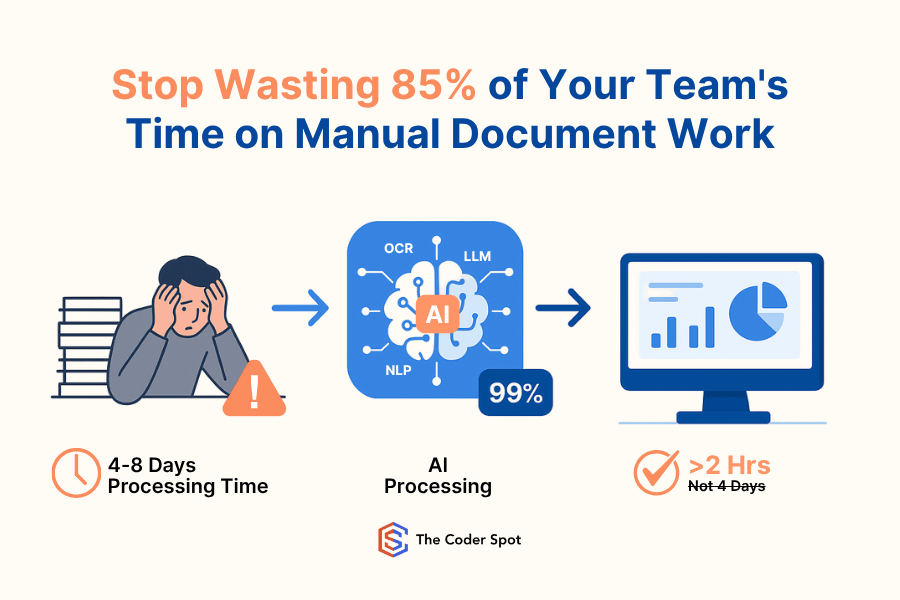Every business runs on documents like contracts, invoices, compliance records, field reports, onboarding forms, legal paperwork, and more. However, as companies grow, they face new challenges with their documentation. Manual processing can slow down decision-making, increase costs, create audit risks, and leave leaders without clear visibility.
AI-powered document processing addresses these issues. This technology is now proven, scalable, and driving significant changes in industries such as construction, logistics, maintenance, finance, and manufacturing.
In 2025, AI document processing has become one of most effective ways to automate workflows. It reduces administrative burdens, uncovers operational problems, and provides leaders with real-time insights. This article explains why it is quickly becoming a vital tool for businesses in the coming decade.
The Global Shift: Document Processing Becomes Business Infrastructure

The market for Intelligent Document Processing (IDP) is expected to grow from $1.5 billion in 2023 to over $15 billion by 2030. But this isn’t just about market size, it shows how businesses are changing the way they handle important processes.
Why the explosion?
🔧 Rising Labor Costs
Admin work is one of the biggest hidden costs for companies. Automating documents reduces the need for data entry workers, allowing teams to focus on more valuable tasks.
📈 Data-Driven Operations
Companies require organized and easy-to-access data for dashboards, ERPs, and analytics tools. Relying on static PDFs and spreadsheets slows down decision-making.
📋 Growing Compliance Requirements
Staying compliant with rules about audits, version control, GDPR, tax, and legal documents is becoming more complicated worldwide.
🚀 Advancing Technology
With new systems like OpenAI GPT-4o, LayoutLM, Azure Document Intelligence, and Google Gemini, accuracy rates for processing complex documents have improved to over 95%.
⚠️ Cost of Inaction
Organizations that wait to adopt automation face higher error rates, financial penalties, and a loss of competitive edge as their competitors become more efficient.
The True Cost of Manual Document Handling (And Why It’s Breaking Businesses)

Manual processing isn’t just slow, it also increases risk and makes it hard for businesses to adapt.
Invoice Processing Bottlenecks
- Missed early-payment discounts costing 1-2% of spend
- Wasting time chasing approval signatures
- Facing duplicate payments and vendor disputes
Data Entry Errors
- Incorrect invoice amounts leading to profit loss
- Wrong purchase order matching messing up accounting systems
- Misclassified expenses leading to inaccurate reports
Contract Blind Spots
- Missing renewal dates resulting in lost revenue
- Not enforcing penalties due to overlooked obligations
- Legal risks from poor clause management
Field Report Problems
- Missing safety logs causing compliance issues
- Poor visibility in job costing and resource allocation
- Delays in leadership information by 48-72 hours
Compliance and Audit Risks
- Failing regulatory audits because of missing documents
- Facing penalties for incomplete tax filings
- Legal disputes lacking proper audit trails
In total, companies often lose 4-8% of revenue due to avoidable administrative mistakes.
How AI-Powered Document Processing Works (The Technology Stack)

Unlike simple OCR or scanning, enterprise-grade AI document processing goes beyond simple scanning. It mimics human thinking without getting tired or biased. Here’s how it works:
The Technology Framework:
- Optical Character Recognition (OCR): Converts paper documents, images and PDFs into text.
- Computer Vision: Reads layouts, tables, and non-standard formats.
- Natural Language Processing (NLP): Interprets clauses, intent, and contextual meaning.
- Machine Learning: Continuously improves accuracy based on your unique document types.
- Large Language Models (LLMs): Adds advanced contextual reasoning (GPT-4o, Gemini, Claude 3).
- Enterprise Integration Layer: Feeds structured data into ERP, CRM, finance, HR, and compliance systems.
- Human-in-the-loop Workflows: Escalates anomalies or exceptions requiring expert review.
This tech stack creates a system that learns from each document it processes, making future tasks faster and more accurate.
Use Case 1: AI Invoice Processing – The Fastest ROI in Enterprise Automation
A logistics company processes over 1,000 supplier invoices each month across 7 departments. Manual processing requires 3 full-time employees, which often leads to overpayments and delays vendor approvals by 3 to 5 business days.
AI Transformation:
- Captures invoices directly from email or cloud folders.
- Extracts vendor, PO, tax codes, line items, and payment terms with 99% accuracy.
- Automatically matches invoices with purchase orders and receipts.
- Quickly escalates mismatches to finance supervisors.
- Integrates smoothly with SAP or other ERP for easy approvals.
Business Impact:
- Reduced administrative workload by 85%.
- Cut processing time from 4 days to just 4 hours.
- Lowered error rates to below 0.5%.
- Annual savings of €55,000 in labor costs and €25,000 in avoided early payment penalties.
Advanced Capabilities:
- Initiates vendor disputes for pricing mismatches automatically.
- Detects fraud instantly by identifying duplicate invoices.
- Normalizes currency across global operations for better efficiency.
Use Case 2: Contract Intelligence – Reducing Legal Risks
The Challenge: A construction contractor handles hundreds of vendor and subcontractor agreements each year. They face problems like missed deadlines, poor tracking of insurance compliance, and inconsistent reviews of contract clauses. These issues can lead to lost revenue and legal disputes.

AI Transformation:
- The system extracts important details like renewal dates, obligations, indemnity clauses, and insurance requirements.
- Automatically triggers renewal alerts, compliance checks, and milestone reminders.
- It flags risky or non-standard clauses for legal review.
- It generates secure logs to keep track of changes.
Business Impact:
Depending on scale, contract automation can deliver substantial risk reduction and cost savings:
- Mid-Market (500–1,000 employees): Up to €500K saved by automating renewals, flagging risky clauses, and enforcing insurance compliance.
- Large Regional (1,000–5,000 employees): €750K–€1M saved via faster legal reviews, reduced litigation, and fewer contract breaches.
- Global Enterprise (5,000+ employees): €2M+ saved annually through global compliance monitoring, cross-border risk scoring, and proactive legal oversight.
Global Compliance Complexity — Handled Intelligently:
AI-powered contract processing adapts to the regulatory demands of each market, automatically recognizing safety, labor, and supplier obligations across regions:
- North America: OSHA, Davis-Bacon Act, work-hour compliance.
- Europe: EU Construction Safety, cross-border labor rules, Forced Labour regulations.
- Middle East: Saudi Building Code, UAE labor laws, Kafala workforce reforms.
This smart automation reduces contract disputes, lowers legal risks, and helps maintain compliance. It prevents expensive penalties that can reach millions.
Advanced Capabilities:
- AI-driven risk scoring across contracts
- Regional compliance flagging based on jurisdiction
- Real-time contract dashboards for executive visibility
Use Case 3: Field Log Automation – Real-Time Operational Visibility
The Challenge: A property maintenance company gathers over 60 daily logs from field technicians using paper forms, photos, and voice notes. Management gets updated summaries several days later, which makes it hard to allocate resources effectively.
AI Transformation:
- Turns handwritten notes, mobile photos, and audio files into organized reports.
- Extracts job codes, technician names, materials used, and safety checklists.
- Updates live dashboards for supervisors and project managers.
- Auto-generates compliance reports and payroll prompts.
Business Impact:
- Reporting delays drop from 72 hours to under 1 hour.
- Technician scheduling efficiency improves by 25%.
- Identifies maintenance backlogs and safety issues faster.
- Eliminates the need for manual data entry.
Advanced Capabilities:
- Predictive resource planning based on job data.
- Flags recurring equipment failures early.
- Triggers customer billing automatically when work is done.
Why This Applies to Every Business – From Construction to Financial Services

Document processing isn’t just a technical upgrade; it’s a key way to automate operations that powers:
- Finance (invoices, expense claims, reconciliations)
- Legal (contracts, NDAs, compliance disclosures)
- HR (onboarding forms, certifications, benefits processing)
- Operations (job logs, inspections, reporting)
- Procurement (POs, supplier verifications)
- Compliance (audit logs, licensing, insurance tracking)
Regardless of industry, every department benefits from:
- Near-instant information availability
- Decision-making speed
- Reduced reliance on manual labor
- Improved customer/vendor experience
- Audit-proof compliance posture
The Real ROI Impact for Leadership Teams
| KPI | Typical Gains After AI Implementation |
| Admin Workload | ↓ 70–85% |
| Document Accuracy | ↑ 98–99% |
| Audit Readiness | 100% digital trails |
| Processing Cycle Time | ↓ 80% faster approvals |
| Annual Admin Cost | ↓ €50K–€150K savings |
| Compliance Violations | ↓ 90% risk reduction |
Why Businesses Choose The Coder Spot for AI Automation
AI document processing is about more than just reducing paperwork; it’s about transforming how businesses operate and compete. To achieve true enterprise-grade automation, you need more than basic software tools. You need expert knowledge, precise engineering, and a partner who understands both technology and business operations.
At The Coder Spot, we don’t sell one-size-fits-all platforms. We architect tailored automation solutions that align with your business model, integrate seamlessly with your existing systems, and scale with your organization.
With years of hands-on experience building custom solutions for industries like construction, logistics, maintenance, manufacturing, and professional services, we’ve seen firsthand where most automation projects fail—and how to ensure long-term success.

We’ve successfully helped companies like Global Coatings modernize their operations, handling everything from lead capture and quoting to inventory management and financial reconciliation. This brings real visibility to operations while boosting both revenue and bottom-line efficiency.
Our advantage is not just in the software, but in how we build your solution:
- Custom enterprise-grade AI models — trained specifically on your documents, workflows, and compliance requirements.
- Deep ERP, CRM, and accounting integrations — SAP, NetSuite, Oracle, Zoho, Salesforce, Xero, and more.
- Industry-specialized automation frameworks — purpose-built for construction, logistics, maintenance, and complex B2B operations.
- End-to-end project delivery — fully managed from initial design to deployment, training, and long-term optimization.
- Human-centered design — blending automation with intelligent exception handling to keep full control where it matters.
- Proven results — from transforming high-volume invoice processing to delivering real-time field operations dashboards.
For companies that view AI automation as mission-critical to growth—not just a back-office task—The Coder Spot delivers the expertise, engineering, and industry knowledge to minimize risk and accelerate return on investment.
Conclusion
Every hour your teams spend manually processing documents is time stolen from higher-value work. Every delay in approvals, errors in data entry, or missing contract obligation represents unnecessary financial risks.
AI-powered document processing removes this burden and gives businesses control over their data operations, real-time insights, and compliance — without needing more administrative staff.
The businesses scaling fastest today are those who have embraced intelligent automation not as a short-term cost saver, but as long-term operational infrastructure.
In 2025, AI document processing isn’t an experiment — it’s becoming a fundamental pillar of how competitive businesses operate, scale, and lead.













